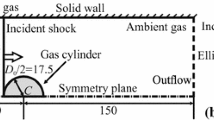Abstract
Interaction of a planar shock wave with a discontinuous \(\hbox {SF}_6\) elliptic gas cylinder surrounded by air is investigated. Special attention is given to the effects of aspect ratio on wave pattern, interface evolution, and material mixing. An ideal discontinuous two-dimensional gas cylinder is created by the soap film technique in experiments, and the shocked flow is captured by schlieren photography combined with a high-speed video camera. The surface of the gas cylinder is clear enough to observe the shock motions, and the distinct interface boundaries allow us to extract more details. As aspect ratio varies, the shock focusing process is quite different. For the prolate gas cylinder, an inward jet is produced although an internal shock focusing firstly occurs. The inward jet has never been observed in membraneless prolate ellipse experiments probably because the inward jet is so faint due to less vorticity generation on membraneless interface that it is difficult to be observed. For the oblate gas cylinder, a secondary vortex pair, which has not been described clearly in previous work, is derived from the downstream interface. The material lines at early stages are extracted from experiments, which grow faster as aspect ratio increases. The interfacial area, the mean volume fraction and the mixing rate are presented from computations, and the results show that the increase of aspect ratio promotes the mixing between gases.










Similar content being viewed by others
References
Richtmyer, R.D.: Taylor instability in shock acceleration of compressible fluids. Commun. Pure Appl. Math. 13, 297–319 (1960)
Meshkov, E.E.: Instability of the interface of two gases accelerated by a shock wave. Fluid Dyn. 4, 101–104 (1969)
Arnett, W.D., Bahcall, J.N., Kirshner, R.P., et al.: Supernova 1987A. Annu. Rev. Astron. Astrophys. 27, 629–700 (1989)
Lindl, J., Landen, O., Edwards, J., et al.: Review of the national ignition campaign 2009–2012. Phys. Plasmas 21, 020501 (2014)
Haas, J.F., Sturtevan, B.: Interaction of weak shock waves with cylindrical and spherical gas inhomogeneities. J. Fluid Mech. 181, 41–76 (1987)
Jacobs, J.W.: Shock-induced mixing of a light-gas cylinder. J. Fluid Mech. 234, 629–649 (1992)
Jacobs, J.W.: The dynamics of shock accelerated light and heavy gas cylinders. Phys. Fluids A 5, 2239–2247 (1993)
Tomkins, C.D., Kumar, S., Orlicz, G.C., et al.: An experimental investigation of mixing mechanisms in shock-accelerated flow. J. Fluid Mech. 611, 131–150 (2008)
Olmstead, D., Wayne, P., Yoo, J., et al.: Experimental study of shockaccelerated inclined heavy gas cylinder. Exp. Fluids 58, 71–91 (2017)
Olmstead, D., Wayne, P., Simons, D., et al.: Shock-driven transition to turbulence: emergence of power-law scaling. Phys. Rev. Fluids 2, 052601(R) (2017)
Tomkins, C., Prestridge, K., Rightley, P., et al.: Flow morphologies of two shockaccelerated unstable gas cylinders. J. Vis. 5, 273–283 (2002)
Tomkins, C., Prestridge, K., Rightley, P., et al.: A quantitative study of the interaction of two Richtmyer–Meshkov unstable gas cylinders. Phys. Fluids 15, 986–1004 (2003)
Kumar, S., Orlicz, G., Tomkins, C., et al.: Stretching of material lines in shock-accelerated gaseous flows. Phys. Fluids 17, 082107 (2005)
Kumar, S., Vorobieff, P., Orlicz, G., et al.: Complex flow morphologies in shockaccelerated gaseous flows. Physica D 235, 21–28 (2007)
Zou, L., Liu, C., Tan, D., et al.: On interaction of shock wave with elliptic gas cylinder. J. Vis. 13, 347–353 (2010)
Bai, J., Zou, L., Wang, T., et al.: Experimental and numerical study of shock-accelerated elliptic heavy gas cylinders. Phys. Rev. E 82, 056318 (2010)
Zou, L., Huang, W., Liu, C., et al.: On the evolution of double shock-accelerated elliptic gas cylinders. ASME J. Fluids Eng. 136, 091205 (2014)
Zou, L., Liao, S., Liu, C., et al.: Aspect ratio effect on shock-accelerated elliptic gas cylinders. Phys. Fluids 28, 036101 (2016)
Zhang, W., Zou, L., Zheng, X., et al.: Numerical study on the interaction of a weak shock wave with an elliptic gas cylinder. Shock Waves (2018). https://doi.org/10.1007/s00193-018-0828-y
Wang, M., Si, T., Luo, X.: Generation of polygonal gas interfaces by soap film for Richtmyer–Meshkov instability study. Exp. Fluids 54, 1427–1435 (2013)
Wang, X., Yang, D., Wu, J., et al.: Interaction of a weak shock wave with a discontinuous heavy-gas cylinder. Phys. Fluids 27, 064104 (2015)
Ding, J., Si, T., Chen, M., et al.: On the interaction of a planar shock with a three-dimensional light gas cylinder. J. Fluid Mech. 828, 289–317 (2017)
Ou, J., Ding, J., Luo, X., et al.: Effects of Atwood number on shock focusing in shock–cylinder interaction. Exp. Fluids 59, 29–39 (2018)
Ray, J., Samtaney, R., Zabusky, N.: Shock interactions with heavy gaseous elliptic cylinders: two leeward-side shock competition modes and a heuristic model for interfacial circulation deposition at early times. Phys. Fluids 12, 707–716 (2000)
Jiang, G., Shu, C.: Efficient implementation of weighted ENO schemes. J. Comput. Phys. 126, 202–228 (1996)
Yang, J., Kubota, T., Zukoski, E.: Application of shock-induced mixing to supersonic combustion. AIAA J. 31, 854–862 (1993)
Acknowledgements
This work was supported by the National Natural Science Foundation of China (Grants 11772329 and U1530103) and the Science Challenge Project (Grant TZ2016001).
Author information
Authors and Affiliations
Corresponding author
Rights and permissions
About this article
Cite this article
Ou, J., Zhai, Z. Effects of aspect ratio on shock-cylinder interaction. Acta Mech. Sin. 35, 61–69 (2019). https://doi.org/10.1007/s10409-018-0819-3
Received:
Revised:
Accepted:
Published:
Issue Date:
DOI: https://doi.org/10.1007/s10409-018-0819-3




